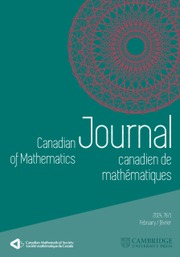No CrossRef data available.
Article contents
Characterizing Complete Erdős Space
Published online by Cambridge University Press: 20 November 2018
Abstract
The space now known as complete Erdős space  ${{\mathfrak{E}}_{\text{c}}}$ was introduced by Paul Erdős in 1940 as the closed subspace of the Hilbert space
${{\mathfrak{E}}_{\text{c}}}$ was introduced by Paul Erdős in 1940 as the closed subspace of the Hilbert space  ${{\ell }^{2}}$ consisting of all vectors such that every coordinate is in the convergent sequence
${{\ell }^{2}}$ consisting of all vectors such that every coordinate is in the convergent sequence  $\left\{ 0 \right\}\cup \left\{ 1/n:n\in \mathbb{N}\\right\}$ . In a solution to a problem posed by Lex
$\left\{ 0 \right\}\cup \left\{ 1/n:n\in \mathbb{N}\\right\}$ . In a solution to a problem posed by Lex  $G$ . Oversteegen we present simple and useful topological characterizations of
$G$ . Oversteegen we present simple and useful topological characterizations of  ${{\mathfrak{E}}_{\text{c}}}$ . As an application we determine the class of factors of
${{\mathfrak{E}}_{\text{c}}}$ . As an application we determine the class of factors of  ${{\mathfrak{E}}_{\text{c}}}$ . In another application we determine precisely which of the spaces that can be constructed in the Banach spaces
${{\mathfrak{E}}_{\text{c}}}$ . In another application we determine precisely which of the spaces that can be constructed in the Banach spaces  ${{\ell }^{p}}$ according to the ‘Erdős method’ are homeomorphic to
${{\ell }^{p}}$ according to the ‘Erdős method’ are homeomorphic to  ${{\mathfrak{E}}_{\text{c}}}$ . A novel application states that if
${{\mathfrak{E}}_{\text{c}}}$ . A novel application states that if  $I$ is a Polishable
$I$ is a Polishable  ${{F}_{\sigma }}$ -ideal on
${{F}_{\sigma }}$ -ideal on  $\omega $ , then
$\omega $ , then  $I$ with the Polish topology is homeomorphic to either
$I$ with the Polish topology is homeomorphic to either  $\mathbb{Z}$ , the Cantor set
$\mathbb{Z}$ , the Cantor set  ${{2}^{\omega }},\,\mathbb{Z}\,\times \,{{2}^{\omega }}$ , or
${{2}^{\omega }},\,\mathbb{Z}\,\times \,{{2}^{\omega }}$ , or  ${{\mathfrak{E}}_{\text{c}}}$ . This last result answers a question that was asked by Stevo Todorčević.
${{\mathfrak{E}}_{\text{c}}}$ . This last result answers a question that was asked by Stevo Todorčević.
Information
- Type
- Research Article
- Information
- Copyright
- Copyright © Canadian Mathematical Society 2009

